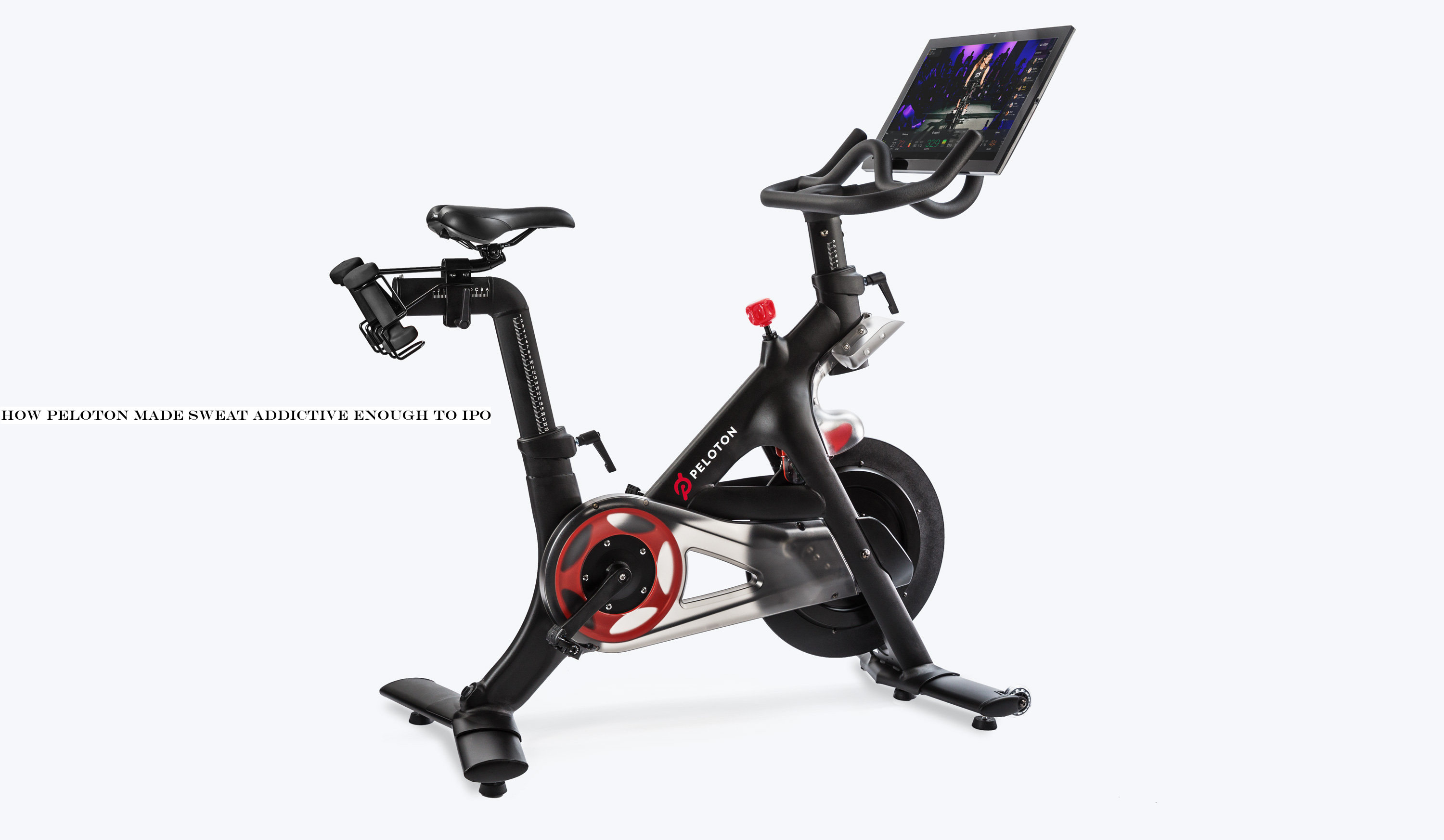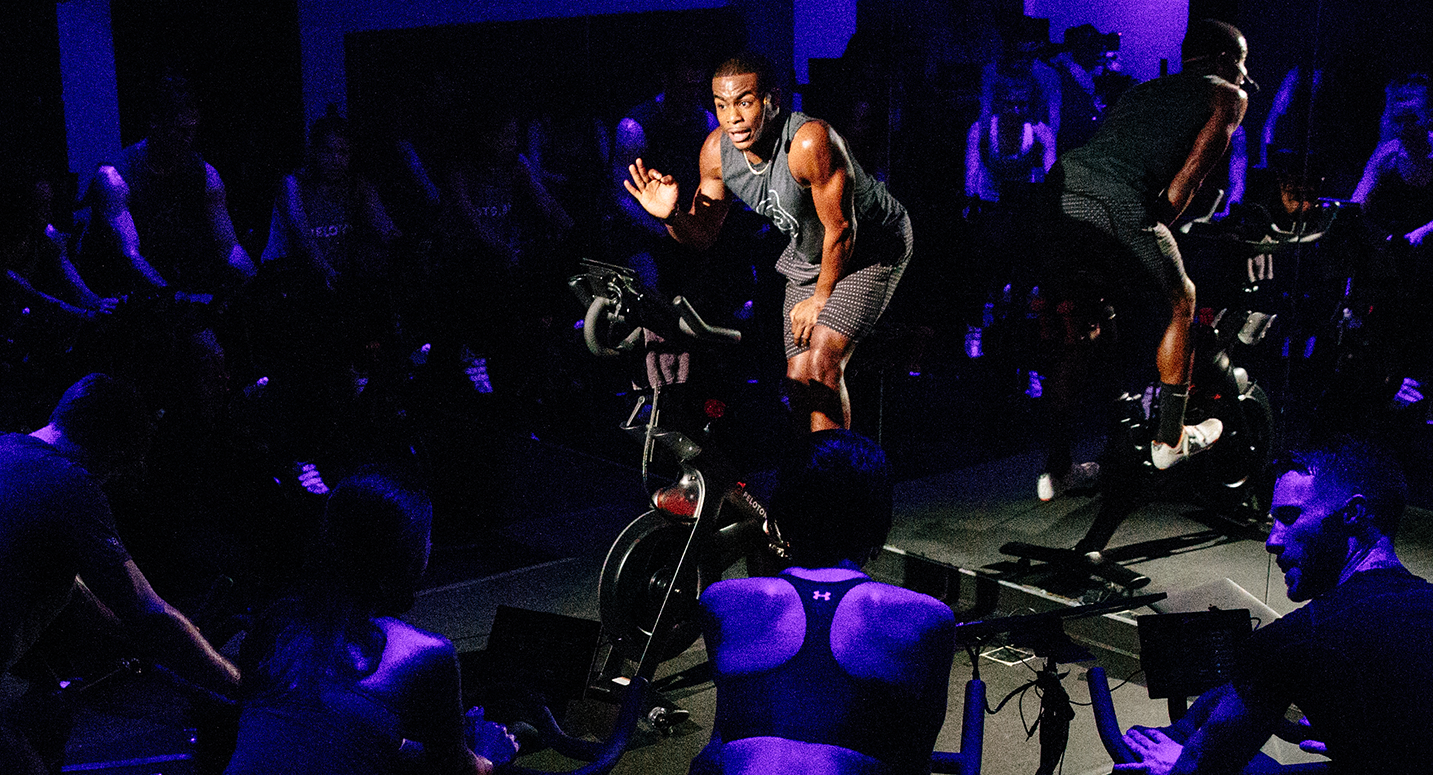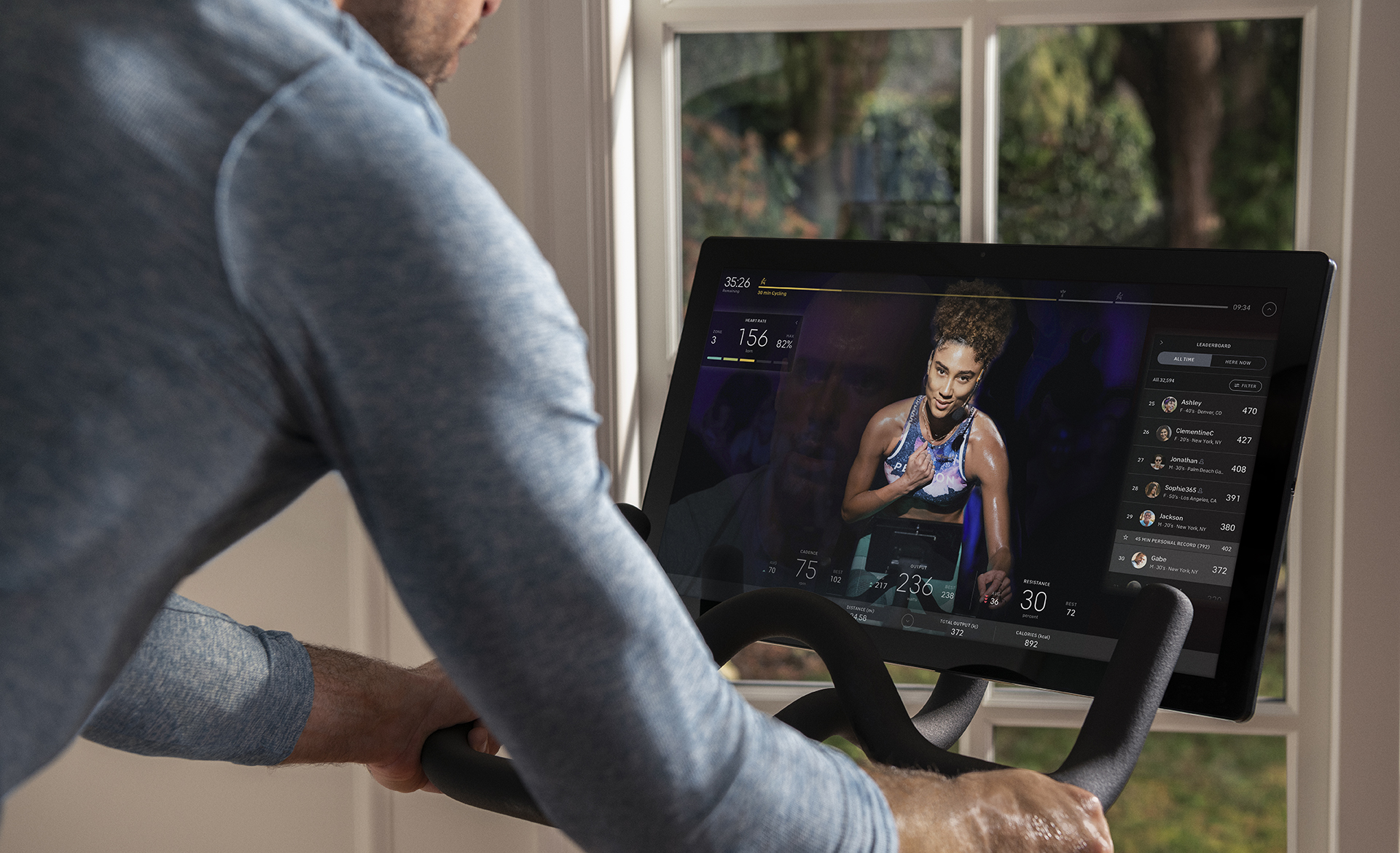Music
Trailers
DailyVideos
India
Pakistan
Afghanistan
Bangladesh
Srilanka
Nepal
Thailand
StockMarket
Business
Technology
Startup
Trending Videos
Coupons
Football
Search
Download App in Playstore
Download App
Best Collections
Technology
It makes lazy people like me work out. Thatthe genius of the Peloton bicycle. All you have to do is velcro on the shoes and you&re trapped. You&ve eliminated choice and you will exercise.Through a succession of savvy product design choice I&ll break down here, Peloton removes the friction to getting fit. Itthe leader in a movement I call &pushbutton health&. And this is why I think Peloton will be a big succes no matter what short-term investors do when it IPOs this week after raising $994 million in venture capital.

The bike
Basically, Peloton is a $2300 stationary bike with a tablet stuck to the front. The $40 per month subscription unlocks thousands of live and on-demand video cycling classes where instructors positively yell at you. When you think you&re tired already, they look into your eyes, tell you &you got this&, the soundtrack crescendos, you crank up the resistance, and you pedal harder at home. The resulting endorphin rush is addictive, and you find yourself persuading friends they need a Peloton too.
That viral loop which adds to its 500,000 subscribers is how Peloton plans to raise ~$1.16 billion going public this week at an ~$8 billion valuation. Its revenue doubled this year as it began to dominate the connected exercise equipment market, though losses quadrupled as it burned cash to become a household name. But after riding 110 of 150 days I&ve been home since buying its bike, I&m confident in the company. Whatever it invests now to build its lead will likely be paid back handsomely by its increasingly handsome customers who can&t bear to clip out. Herewhy.

Peloton classes are recorded in front of a live studio audience of riders
The Brilliance Of This Bike
The Shoes & Usually the activation energy to start a workout requires dragging yourself to the gym or suiting up to face the elements outside. That can be daunting enough that you rarely do. But once you slip into the Peloton bike shoes, you can hardly walk normally which means you can hardly procrastinate. You&re home so you don&t even need clothes. Just a few velcro straps and you&re over the hump and resigned to exercise.
The Clips & Home gym equipments reduces the barrier to entry but also the barrier to exit. You can tell yourself you&ll keep doing push-up sets or squats jumping rope, but you can stop any time. Yet after you&re clipped into the Peloton bike, you&re almost assured to keep pedaling until the instructor gives you that end-of-ride congratulations.

Just put the shoes on and you&ll exercise
The Schedule & You can get a sweat in just 10 or 20 minutes going hard on a Peloton. Combined with zero commute, that means you&ll practically always be able fit in a ride regardless of how busy you are. No more &I don&t have time to make it to the gym so I&ll just skip out&. When my calendar gets crunched or I dawdle a little before deciding to ride, classes as short as 5 minutes ensure thereno weaseling out.
The Instructors & I wish I had these coaches to motivate me through sorting email. Peloton20+ instructors range from hippie-dippie gurus to no-nonsense trainers that fit your personality type. You find yourself craving your favoritespecial brand of relentless positivity. I burn far more calories in a shorter time than exercising solo because they inspire me to push a little harder or they slow their countdown to add a couple all-out seconds to the end of a sprint. They&re even becoming celebrities, with bankers lining up for selfies during PelotonIPO road show. Sick of them? You can always Scenic Ride through video of some of the worldprettiest bike paths.

Peloton instructors (from left): Alex Toussaint, Emma Lovewell, Ben Alldis, and Leane Hainsby
The Intimacy & You&re eye-to-eye with those instructors as they stare into the camera and out of the giant screen bolted to your handlebars. That generates intimacy despite them broadcasting to thousands. Even in person, a SoulCycle coach across the room can feel further away. You&re mostly guided by audio cues, but their gaze compels you to perform. Peloton almost feels like FaceTime, and thata sense of connection many long for more of these days.
The Pavlovian Response & Your brain quickly begins to associate the sounds of Peloton with the glowing feeling of finishing a workout. The rip of the velcro shoe straps, the click of clipping into the bike, but most of all the instructor catch-phrases. You get hooked on hear the bubbling British accent of &I&mmmm Leeaannne Haaaaainsby& as she introduces herself, Ben Alldis& infectious &You got 5, you got 4…& countdowns, or Emma Lovewell reminding you to &Live, learn, love well&. That final ‘namaste& followed by wiping down the bike and jumping in a cold shower forms a ritual you&re inclined to repeat.

Eye-contact with the instructors creates an intimate bond
The Soundtrack & Popular songs are more than just a pump-up accompaniment to Peloton classes. Your pedaling pace is often pegged to the tempo, with sprints starting when the beat drops. As your legs tire, you feel obliged to maintain your speed so you don&t fall behind the drums. You can even search classes by music genre and preview eachplaylist. Peloton has paid out $50 million in royalties for its music, and faces $300 million-plus in lawsuits for copyright infringement. But having the best tunes to bike to might end up worth the penalty since it helped Peloton race ahead in a lucrative market.
The Bike As Decor & Most home exercise equipment ends up in a closet or as a clothing rack. By designing its bicycles for beauty, Peloton coerces you to place them conspicuously in your home. You might have seen the hysterical Twitter thread parodying this practice, but itfunny because ittrue. You&re a lot more likely to ride it if itcentral to your home (ours is between our bed and the doors to the veranda), and you&ll be embarassed if visitors ask about it and you haven&t hopped on recently.

&A good place for your Peloton bike is between your kitchen and your living room facing the cactus garden so you always remember virtual spin class& &ClueHeywood on Twitter
The Network Effect & Many of these smart product design moves could be copied by competitors. But by amassing a community of 1.4 million members to date, Peloton benefits from social features and economies of scale. You can ride together with pals over video chat, send each other digital high fives, or race and compare achievements. Each friend that joins Peloton is one more reason not to sign up for a competitor. The whole concept virtual personal training is being legitimized. And the cost of producing more classes gets spread wider as membership grows.
The Shared Accounts & Peloton has even built in a way to feel noble about your sanctimonious prosyletizing about how it &jumpstarted your metabolism&. Each $39 on-bike subscription allows unlimited accounts on up to three devices, so you can hook up some friends if you convince them to buy the big-budget gadget.

High-five fellow riders as you virtuall pass them
The Growth Hacks & Peloton streaks are for adults what Snapchat streaks are to kids: a clever way to reward consistent usage. But beyond the achievement badges displayed on your profile, you&ll get in-ride leaderboards full of people to proudly pass, progress bars to fill by pedaling, and kilojoule output high scores to beat. Peloton makes exercise a game you want to win.
The Shoutouts & Yet Pelotonmost explicit levering of our psychology comes from the in-class name-drop shoutouts instructors give. Whether mentioning the screen names of a few participants at the start of a session or congratulating users hitting their 50th, 200th, or 500th ride, the recognition pushes people to join the dozen live-streamed classes each day that add urgency to the on-demand catalog. Proof it works? People strategize to ensure their 100th ride is a long live class to maximize the chance of a shout-out.

A free cult shirt after your 100th ride
The ‘Transcendence& & Peloton minimizes the isolation from working out at home. In fact, its whole product enables people to feel ‘glamorous& and ‘manifested& yet nonchalant in ways going to a sweaty gym or using a personal trainer can&t. Itlike being able to buy a little piece of the smug satisfaction and in-group affiliation of going to Burning Man. Thatwhy the company even sends you a free &Century Club& t-shirt when you hit your 100th ride. You&re meant to feel cool sharing that you &Peloton&, using the startupname as a verb.
—

Conspicuous Self-Actualization
Still, Peloton has plenty left to optimize. Thereroom to expand use of its camera to offer premium one-on-one coaching, head-to-head racing, group video chat with friends, and augmented reality filters to make people feel comfortable on screen and take shareable selfies. A wider range of intense but short classes could appeal to overworked professionals who picked Peloton precisely because they don&t have an hour for the gym.
Novelty could come from celebrity guest instructors, or themed classes for pre-gaming for a night out, fans of a particular artist, or songs about a certain topic. And it should definitely have some iconic sounds like an om or singing bowl chime that play before each class to center you and after to release you.
Most excitingly, the Peloton screen has the potential to be a platform for exercise-controlled gaming and apps. Whether pedaling to escape zombies chasing you or piece together a puzzle, maintaining an output level to keep your cross-hairs locked on an enemy plane as you dogfight, or making a garden bloom by growing each flower during a different interval, Peloton could evolve riding to be much more interactive. Apps could offer training simulators for different sports focused on sprints for basketball or marathons for soccer. Or just put Netflix on it! By opening up to outside developers, Peloton could build a moat of extra experiences competitors can&t match.
With the strengths and opportunities of its core product, Peloton is poised to absorb more of your fitness time and money. Italready branching out with yoga, meditation, lifting, bootcamp, and jazzercise classes you can do standing next to your bike or without one on its $19 per month app. Its second gadget is a $4300 treadmill.
From there it could break into more of the &pushbutton health& business. I categorize these as wellness products and services that rely on convenience instead of your will power. Think delivery health food instead calorie-counting apps that are a chore. My pushbutton regimen includes Peloton, six salads per week dropped off in batches by Thistle, monthly packages of Nomiku vacuum-sealed meals that RFID scan into its sous vide machine, and a Future remote personal trainer who nags me by text message.

Iteasy to get hooked on the positivity
Peloton could easily dive into selling meal kits, personal training, or a wider range of workout clothes to compete with Lulu Lemon. If itthe center of your fitness routine, the company could become a gateway to new health products it owns or partners with.
I&m bullish on Peloton because I&m betting people are going to stay busy, lazy, and competitive. It offers the effectiveness of a spin class but with scheduling flexibility. It removes every excuse for staying on the couch. And in an age of visual communication where many seek to share both the journey to and the destination of an Instagrammable body and the discipline to ge there, Peloton provides conspicuous self-actualization through consumerism. Plus, finishing a ride feels damn good.
- Details
- Category: Technology
Read more: How Peloton made sweat addictive enough to IPO
Write comment (100 Comments)
If you&re at all familiar with esports, chances are you&ve heard of 100 Thieves. The esports org, founded by Matthew &Nadeshot& Haag, has grown over the past couple years into an absolute powerhouse of esports and a household name for those who follow gaming.
Which is why we&re thrilled to have Nadeshot and 100 Thieves part owner Scooter Braun join us at Disrupt SF 2019.
Matthew Haag got his start as a pro gamer when esports were still in their infancy. He became one of the most decorated esports athletes in history, serving as Captain of the legendary Optic Gaming CoD team where he led the team to an X Games Gold Medal and a CoD World Championship.
In 2015, Nadeshot retired from competitive gaming and started some of the most-watched YouTube and Twitch channels in the gaming world. A year later, he founded his own esports org with 100 Thieves, which combines streaming content, competitive esports and apparel under a single brand name.
Scooter Braun is one of the biggest names in the entertainment industry, managing megastars like Justin Bieber and Arianna Grande. But Bruan is also the founder of SB Projects, which is a highly diversified media company that focuses on music management, film/TV, as well as Silent Labs, a tech incubator which holds investments in companies like Uber, Spotify, Songza, Casper, Waze, and Pinterest.
Braun is also at the helm of Ithica Holdings, which made waves this year with the acquisition of Big Machine Label Group (Taylor Swiftformer label). Ithica also owns Mythos Studios with Marvel Founding Chairman David Maisel, Atlas Publishing and has partnerships with various management companies.
In 2018, Drake and Scooter Braun became co-owners in 100 Thieves through a $25 million Series A investment.
At Disrupt SF, we&ll ask Braun and Nadeshot about the opportunities ahead in the esports industry, what itlike to grow a brand and team from scratch, and how they see esports evolving over the next few years.
Nadeshot and Braun join an amazing list of speakers, including Joseph Gordon-Levitt, Will Smith and Ang Lee, Snap CEO Evan Spiegal, Zola CEO Shan Lyn Ma, and many more.
Disrupt runs October 2 to October 4 right in San Francisco. If you still need tickets, you can pick those up right here.
- Details
- Category: Technology
Read more: 100 Thieves’ Nadeshot and Scooter Braun are coming to Disrupt
Write comment (94 Comments)
&Terrace House& (a co-production between Netflix and Fuji Television) is back, and it hasn&t changed much since we reviewed it last year.
As with previous seasons, &Terrace House: Tokyo 2019-2020& features six cast members (three men and three women, mostly in their twenties) who all live in a house together. Rather than manufacturing competition or drama, the show largely allows everyone to go about their normal lives, while also tentatively exploring romance with their castmates.
On the latest episode of the Original Content podcast, we talk about our impressions of the new cast members. Then Anthony grills Darrell (whowatched every episode) about why he continues to find the reality TV franchise so addictive.
Apparently it boils down to the fact that the formula works: Ita beautifully-produced show, with a likable, attractive cast. And the producers continue to resist any temptation to ramp up the drama to match American TV.
We also discuss NBCUniversalannouncement that its upcoming streaming service will be called Peacock, and it will feature a reboot of &Battlestar Galactica.&
You can listen in the player below, subscribe using Apple Podcastsor find us in your podcast player of choice. If you like the show, please let us know by leaving a review on Apple. You can also send us feedback directly. (Or suggest shows and movies for us to review!)
And if you&d like to skip ahead, herehow the episode breaks down:
0:00 Intro 0:43 Listener to response to &The Family& review 1:55 NBCUniversal/Peacock news 12:56 &Terrace House: Tokyo 2019-2020& review (mild spoilers)
- Details
- Category: Technology
According to a new WSJ report, certain members of WeWorkseven-person board, which includes cofounder and CEO Adam Neumann, are planning to pressure Neumann to step down and instead become Wenon-executive chairman. The move, says the outlet, &would allow him to stay stay at the company he built into one of the countrymost valuable startups, but inject fresh leadership to pursue an IPO that would bring We the cash it needs to keep up its torrid growth.&
The WSJ and Bloomberg are reporting that it is SoftBank specifically that wants Neumann to step down. Neither WeWork nor SoftBank is commenting publicly.
Ita fascinating development, the kind we saw when Uberboard successfully forced cofounder and longtime CEO Travis Kalanick to abandon his role as CEO. Still, we&d caution against drawing too close a comparison. While the venture firm Benchmark, which spearheaded Kalanickouster, stood to lose billions of dollars if Kalanick dragged down Uber and continued to push off an IPO, Benchmark was not in a do-or-die situation because of its Uber investment.
SoftBank appears to be in more dire straights, making this standoff a particularly meaningful one.
Letback up a minute first, though, and consider who is involved and which way this could potentially go. A few days ago, Business Insider put together a useful cheat sheet about WeWorkboard members that may hint at their allegiance.
1.) Ronald Fisher — who is vice chairman at SoftBank Group after founding SoftBank Capital, a U.S. venture arm of SoftBank — joined SoftBankboard last year. He oversees 114 class A shares, each of which carries one vote. Obviously, hegoing to side with SoftBank.
2.) Lewis Frankfort — the chairman of a fitness studio chain called Flywheel Sports — has been a board member of WeWork for roughly five years, and BI says WeWork once loaned him $6.3 million, which he repaid with interest earlier this year. We have to think he&d stick with Neumann out of loyalty. At the same time, he doesn&t wield much power unless he has the right to block significant actions at the company (some shareholders get these blocking rights; some don&t.) What he know: he controls 2 million shares, and 750,000 of them are Class B shares that carry 10 votes each.
3.) Benchmark, which first backed WeWork in 2012, is represented on the board by Bruce Dunlevie, the founding partner of the venture firm. Benchmark owns 32.6 million Class A shares, and could go either way, seemingly. On the one hand, Benchmark doesn&t want to establish a reputation for pushing out founders after the Kalanick debacle, and if it supports SoftBank over Neumann, it risks this exact thing happening. On the other hand, Benchmark might not want to battle with SoftBank if it thinks it has staying power or itconcerned (suddenly) that it allowed Neumann to amass too much control.
4.) Steven Langman, the cofounder of private equity firm Rhône Group, has ties that go back a ways with Neumann, and he has benefited richly from the association. According to an April story in the WSJ, Langman met Neumann through a shared rabbi in its earlier days and joined the board in 2012. He also invested in the company (he owns 2.28 million shares, according to a bond filing). Langman is on both the companycompensation committee and its succession committee. He also runs a real-estate investment vehicle in partnership with We that buys and develops buildings to then lease back to the co-working company, despite that it raises conflict-of-interest questions. We&d guess heon Team Neumann.
5.) Mark Schwartz is a former Goldman Sachs exec who stepped off the board of SoftBank earlier this year but who remains on WeWorkboard. Why he left SoftBankboard may or may not hold clues here. According to The Information, he remains a confidante of SoftBank CEO Masayoshi Son.
6.) John Zhao is the chairman and CEO of Hony Capital, which partnered with SoftBank and WeWork to create a standalone entity called WeWork China back in 2017, and Hony has subsequently poured more capital into that subsidiary. We&re not sure how close Zhao is to SoftBank, but if SoftBank brought Hony into WeWork, we&re guessing he will back the Japanese conglomerate on this one. Hony doesn&t own 5 percent or more of WeWorkparent company so its share holdings aren&t listed publicly.
Harvard Business School professor Frances Frei also brought in roughly a minute ago to add a much-need sprinkling of gender diversity to WeWorkall-male board. Freiname first came to be more broadly recognized when she was hired to help address Uberbattered culture, so presumably she has ties to Benchmark. We&d guess she&ll side with Dunlevie, meaning that we have no idea whose side she will take.
Neumann, itvery worth noting, is himself is far more powerful than any of these six individuals. Even after the company recently revised Neumannsupervoting rights, which gave him 20 times the voting power of ordinary shareholders and now give him 10, he could fire the entire board if he so chooses, notes the WSJ.
Naturally, that wouldn&t be a good look for Neumann, who is already battling growing public perception that, among other negatives for a public company CEO, he smokes a whole lot of pot and that he may be delusional. (A WSJ piece last week reported that Neumann likes to smoke marijuana with friends and while airborne. It also said that Neumann has confided to different people his interest in becoming Israelprime minister and president of the world.)
All that said, SoftBank is also fast-losing credibility. While its CEO, Son, has been long revered as a visionary, a growing number of sources we&ve spoken to question the viability of his entire Vision Fund operation. They see WeWorkever-soaring valuation on the private market, from $20 billion to, more recently, $47 billion — which was almost single-handedly SoftBankdoing — as just one in a costly string of poor calls.
Indeed, despite the roughly $10 billion that SoftBank has sunk into WeWork, the financial loss it would take if WeWork falls apart would pale in comparison to the reputational hit Son would suffer, and you can bet there will be ripple effects.
Our suspicion: given the Vision Fundimpact on the startup industry over the last few years, therea lot more riding on what happens with WeWork than meets the eye. Stay tuned.
Correction: An earlier version of this story did not include WeWork board member Mark Schwartz.
- Details
- Category: Technology

We might have just completed a full-day program devoted completely to enterprise at TechCrunch Sessions: Enterprise last week, but it doesn&t mean we plan to sell that subject short at TechCrunch Disrupt next month in San Francisco. In fact, we have something for everyone from startups to established public companies and everything in between along with investors and industry luminaries to discuss all-things enterprise.
SaaS companies have played a major role in enterprise software over the last decade, and we are offering a full line-up of SaaS company executives to provide you with the benefit of their wisdom. How about Salesforce chairman, co-CEO and co-founder Marc Benioff for starters? Benioff will be offering advice on how to build a socially responsible, successful startup.
If you&re interested in how to take your startup public, we&ll have Box CEO Aaron Levie, who led his company to IPO in 2015 and Jennifer Tejada, CEO at PagerDuty, who did the same just this year. The two executives will discuss the trials and tribulations of the IPO process and what happens after you finally go public.
Meanwhile, Slack co-founder and CTO Cal Henderson, another SaaS company that recently IPOed, will be discussing how to build great products with Megan Quinn from Spark Capital, a Slack investor.
Speaking of investors, Neeraj Agrawal, a general partner at Battery Ventures joins us on a panel with Whitney Bouck, COO at HelloSign and Jyoti Bansal, CEO and founder of Harness (as well as former CEO and co-founder at AppDynamics, which was acquired by Cisco in 2017 for $3.7 billion just before it was supposed to IPO). They will be chatting about what it takes to build a billion dollar SaaS business.
Not enough SaaS for you? How about Diya Jolly, Chief Product Officer at Okta discussing how to iterate your product?
If you&re interested in security, we have Dug Song from Duo, whose company was sold to Cisco in 2018 for $2.35 billion, explaining how to develop a secure startup. We will also welcome Nadav Zafrir from Israeli security incubator Team 8 to talk about the intriguing subject of when spies meet security on our main stage.
You probably want to hear from some enterprise company executives too. Thatwhy we are bringing Frederic Moll, chief development officer for the digital surgery group at Johnson - Johnson to talk about robots, Marillyn A. Hewson, chairman, president and CEO at Lockheed Martin discussing the space industry and Verizon CEO Hans Vestberg going over the opportunity around 5G.
We&ll also have seasoned enterprise investors, Mamoon Hamid from Kleiner Perkins and Michelle McCarthy from Verizon Ventures, acting as judges at the TechCrunch Disrupt Battlefield competition.
If thatnot enough for you, there will also be enterprise startups involved in the Battlefield and Startup Alley. If you love the enterprise, theresomething for everyone. We hope you can make it.
Still need tickets? You can pick those up right here.
- Details
- Category: Technology
Read more: TechCrunch Disrupt offers plenty of options for attendees with an eye on the enterprise
Write comment (95 Comments)iFixit has disassembled Applenew iPhone models, which tells us more about the differences with last yearphones. iFixit shot a live-stream video of the iPhone 11 Pro teardown and wrote a guide for the iPhone 11 Pro Max.
The first major difference is that the batteries in the iPhone 11 Pro and iPhone 11 Pro Max are much larger than the batteries in the iPhone XS and iPhone XS Max.
On the iPhone 11 Pro Max, the device is .4 mm thicker and the screen is .25 mm thinner. As John Gruber expected, dropping 3D Touch from the iPhone lineup makes the screen slightly slimmer. 3D Touch required an additional layer under the display to register pressure on the screen.
That might feel like a tiny difference, but it frees up some space for the battery. The iPhone 11 Pro and iPhone XS have the same single-cell L-shaped design. But the Max version has been updated to use the came single-cell design instead of two cells.
The result is that the iPhone 11 Pro Max now has a 3,969 mAh battery compared to a 3,179 mAh battery in the iPhone XS Max. It represents a nearly 25% year-over-year improvement for the Max battery.
Those hardware refinements combined with a more efficient A13 system-on-a-chip create some significant battery life improvements for the user. Apple claims that the iPhone 11 Pro and iPhone 11 Pro Max last up to 4 hours and 5 hours longer respectively compared to the previous generation.

(Photo credit: iFixit)
In other news, the camera module is much bigger in this yearnew device (as expected). Apple managed to put a third camera by reducing the size of the logic board.
The logic board has the same dual-layer design that was first introduced with the iPhone X. Itlike a club sandwich of chips. Even though Apple and Qualcomm has settled its multi-billion-dollar lawsuits, the modem in the iPhones 11 Pro is still manufactured by Intel.
When it comes to things that we don&t know yet, iFixit couldn&t figure out how much RAM there is —Steve Troughton-Smith believes there might be 2GB of RAM dedicated to the camera that you wouldn&t notice on benchmarks.
Similarly, there are now two battery connectors instead of one. Ithard to say for sure that the second connector has been added for bilateral wireless charging — it could be there for many different reasons. Rumor has it that Apple wanted to add reverse wireless charging but canned the feature at the last minute.
Overall, iFixit gives a repairability score of 6 out 10. The iPhone XS models also got a 6 out of 10 rating.
- Details
- Category: Technology
Read more: iPhone 11 Pro teardown reveals smaller logic board, larger battery
Write comment (92 Comments)Page 820 of 5614

 5
5





